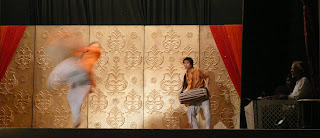Well we’ve made it! The flight on Royal Jordanian was five hours and thirty minutes: the plane was fantastic, and the drinks’ service was great: they came around twice with a very gluggable white wine which was poured copiously from the bottle rather than in those measly little individual bottles! With the plush red seats and perfectly attired stewardesses, it actually eclipses our experience on Virgin Atlantic on the way out. But anyway, onto the final section of our interview:
Jon: Hello Simon
Simon: Hmm. Hello Jon.
Jon: What were your expectations of India before you went?
Simon: Oh very high actually. I had heard that Francis Grier had a spiritual experience when he visited India, and ended up staying and trying to explore Indian music and various alternative therapies. This is what I was searching for, but sadly there was nothing there, it was entirely hollow on a mystical level.
Jon: How did real India compare with your imagination?
Simon: The heady aromas of rose petals in Hindu garlands often filled the air just when we walked down the street: this was even better than the dream! But there again, there were other scents which would always compete with this: often the smoke of simple cooking fires, either burning coals or simple wood fires, and of course the smells of bodily functions which punctuate your progress down the street with every step. We were under-prepared for much of this, but we managed to take this all in our stride.
Jon: Were you particularly shocked by the poverty in Bangladesh?
Simon: At first, it was NOT self-evident. Our first experiences of Bangladesh involved the amazing scenery of West Bengal and then over the border. The flatness is VERY green, and punctuated by small settlements and massive palm trees, together with much water, either in rivers or streams. This scenery immediately evokes the world of Rabindranath Tagore, and was both serene and magical. And then our arrival in Cox’s Bazar made us wonder at the great natural scenery and the warmth of the people. It was only gradually, as we scratched away at the surface that we began to perceive the full horror of life here; yes of course it’s a third-world country, this we knew before setting out, but the reality stops you in your tracks. Even in Cox’s Bazar, just below the surface of the beach life, lies a grim and hideous reality: once beautiful streams now still and overflowing only with rotting garbage and effluent. People continuously discarding all household waste into these addits, and alongside every street, flows open sewers. All this comes as a matter of course in daily life. And then our visit to the shanty settlements, where normal life attempts to take place under great hardships. The beaming smiles of the local people tend to disguise, or at least distract from, the reality of a tiny country, barely forty years into its independence with a population of over 140 million, many of whom suffer overcrowding, poverty, starvation and arsenic poisoning.
Jon: What did you find special about Bangladesh that you can’t find in any of the other countries that we visited?
Simon: Optimism.
Jon: What was the most extreme part of the trip for you?
Simon: By extreme, perhaps you are thinking of the white-water-rafting? Well that was awesome, and we must, must, must try it again over the world. But there was something else extreme: remember the Hindu watermelon festival on Maheskhali Island?
Jon: Ummm…. Yeah?
Simon: The demonic trance of those women, that look was something I’ve never seen before; it was like possession. And I never want to see it again.
Jon: Did the Himalayas in Nepal live up to your expectations?
Simon: Up near the Tibetan border, it exceeded them. It was JUST what I was looking for (minus the monastery).
Jon: What monastery?
Simon: The one in the dream I’ve had since I was a boy, walking in the mountains of the Himalayas in breathtaking scenery and stumbling upon a little Buddhist monastery with candles, prayer wheels and chanting.
Jon: How did you feel when we were wandering lost around the Holy City of Jerusalem?
Simon: For the first time ever, found!
Jon: The Lost City of Petra was spectacular! It is one of the seven new wonders after all. But did that beat the Taj Mahal? And was there anything that particularly grabbed you in Jordan?
Simon: Yes, I think that it DID beat the Taj, by a narrow margin of course. And Jordan grabs you not by its other must-see features, but by its overall atmosphere and great people.
Jon: How does it feel to be on your way home?
Simon: Oh it’s a very special feeling, because travel doesn’t just teach you about what’s out there: it also shows you what’s inside, and what you’ve got already. We’re lucky, aren’t we?
Jon: Oh yes! Well, thanks Simon for a great trip and I really hope that the next one will be just as great!!!
Simon: I’m already off to buy another guidebook…
So thanks for following our exploits. We are glad that you all enjoyed reading up on our antics. All that remains is for a few photos to help jog our memories of some really great times. But keep watching, because who knows, before too long the intrepid duo may be off to another continent. And this time, it’s going to be REALLY extreme!








































